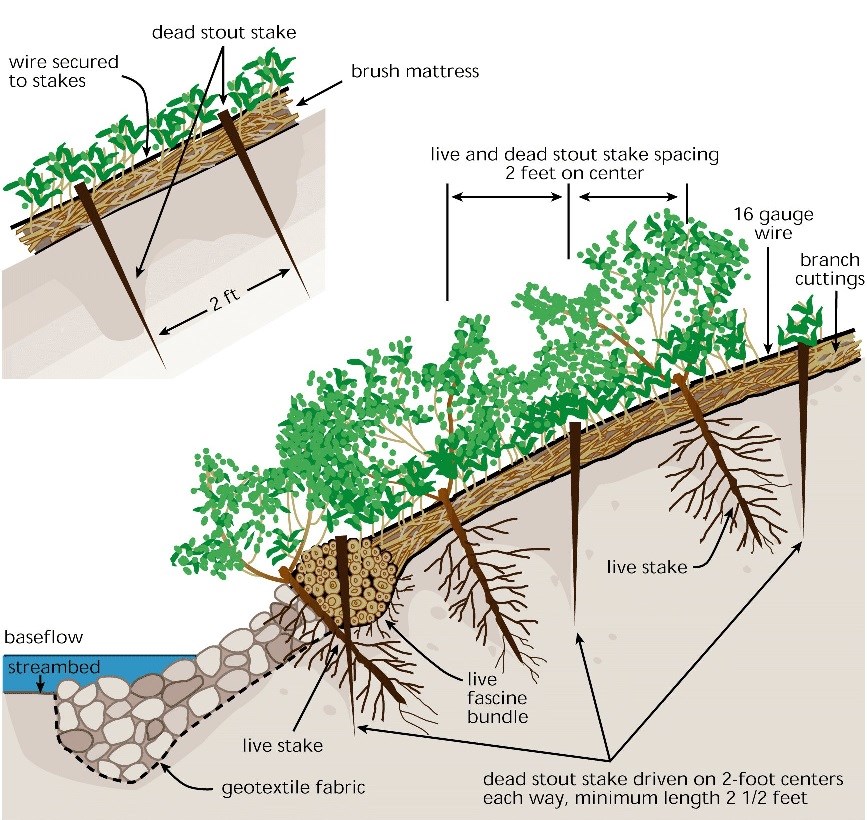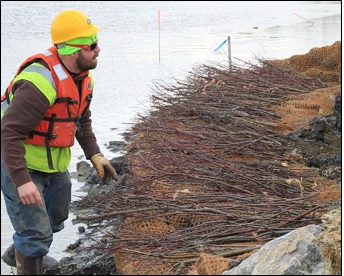Brush Mattresses
Description
Also known as live brush mats or brush matting, a brush mattress is a combination of live stakes, live fascines, and branch cuttings installed to cover and stabilize streambanks.
Brush mattresses are used to form an immediate, protective cover over the streambank. A thick mat of dormant cuttings is placed on the bank and held down with stakes. The goal of a brush mattress is to create structural streambank protection that will eventually root and provide vegetative stabilization (Scheuler). This technique is often used in conjunction with other methods such as live stakes and stone toe protection.
 Image Credit:
Image Credit: Stream Corridor Restoration: Principles, Processes and Practices, 10/98, by the Federal Interagency Stream Restoration Working Group (FISRWG).
Applicability
Brush mattresses can restore riparian vegetation and habitat and enhance conditions for colonization of native plants. They reduce soil erosion and intercept sediment flowing down the streambank. After vegetation reaches a height of a few feet, it can improve fish habitat by shading the stream, lowering water temperatures and offering protection from predators (Allen and Fischenich 2000). Brush mattresses are also useful on steep, fast-flowing streams.
Design Considerations
- The brush mattress is installed by first grading the streambank to the desired stable angle. Brush mattresses are most successful on slopes not exceeding 2:1.
- A shallow trench is then cut behind the toe protection (coir fiber log, boulder revetment, etc.) and the ends of the branch cutting placed in the trench. This trench is to ensure good soil contact and water for the branches to root.
- The branches are laid down perpendicular to the stream flow until the bank is barely visible through the branches. Stakes are then driven partially into the brush mat on two-foot centers.
- In order to insure good soil contact, as much loose soil as possible is then agitated into the brush mat. It is important for the growth of the brush mattress that as much brush mat/bank soil contact is made as possible.
- Because brush mattresses use dormant cuttings, they must be installed during the non-growing season; early spring is best (Scheueler).
- This measure should be initiated in conjunction with a revegetation strategy. Brush mattresses make it more difficult to establish supplemental vegetative plantings once the mats become established.

Effectiveness
The effectiveness of this practice is dependent on the site conditions and material selection. Consult a qualified professional to ensure that the system is designed and installed correctly.
Operation and Maintenance
Operation and maintenance requirements vary depending on the characteristics of the stream system including velocity, flood frequency, flood stage, timing and sediment load. Regardless, the system may need repairs until vegetation becomes well-established. Inspection is necessary after each of the first few floods or at least once per year, preferably after the predominant flood season (Allen and Fischenich 2000). As the brush mattress becomes established and the live cuttings root, maintenance requirements are significantly reduced (Heaton et al 2002).
Costs
A brush mattress that is one square meter in size can be constructed in ½ to 1½ labor hours. Appropriate labor costs should be added to this estimate, including plant harvest, collection, transport, fabrication, and installation. Construction costs for dead stout stakes and coir bristle twine or wire are about $3.00 to $5.00 per square meter (2000 dollars, Allen and Fischenich 2000). Other incidental start-up, cleanup, and site preparation costs such as bank reshaping should also be included. According to Allen and Fischenich (2000), costs for brush mattress projects range from $12 to $24 per square meter, with an average cost of about $18 per square meter. Costs for brush mattresses on projects that are contractor bid, requiring live fascine installation, maintenance, profit margins, and contingency factors, range between $25 and $55 per square meter. Costs can be reduced by using free material from donation sites and volunteer labor. Costs related to project permitting are not included in the above estimates.
References
Allen, H. H. and C. Fischenich. 2000. Brush Mattresses for Streambank Erosion Control. EMRRP Technical Notes Collection (TN EMRRP-SR-23). U.S. Army Engineer Research and Development Center, Vicksburg, MS.
http://el.erdc.usace.army.mil/elpubs/pdf/sr23.pdf
Heaton, M. G., R. Grillmayer and J. G. Imhof. 2002. Ontario’s Stream Rehabilitation Manual. Ontario Streams, Belfountain, Ontario.
http://www.ontariostreams.on.ca
MDE. 2000. Maryland’s Waterway Construction Guidelines. The Maryland Department of the Environment Water Management Administration,
http://www.mde.state.md.us/wetlands/guide.html
Schueler, T. "Stream Restoration: Bank Stabilization Practices." Stormwater Manager’s Resource Center. Center for Watershed Protection, Inc. Accessed 3/7/2002.
http://www.stormwatercenter.net
Streambank and Shoreline Protection Manual. Lake County Stormwater Management Commission, Lake County Planning, Building and Development Department, U.S.D.A. - Natural Resources Conservation Service. 2002.
http://www.usace.army.mil/
FISRWG. 1998. Stream Corridor Restoration: Principles, Processes, and Practices. Federal Interagency Stream Restoration Working Group,
http://www.nrcs.usda.gov/wps/portal/nrcs/detailfull/national/water/?cid=stelprdb1043244